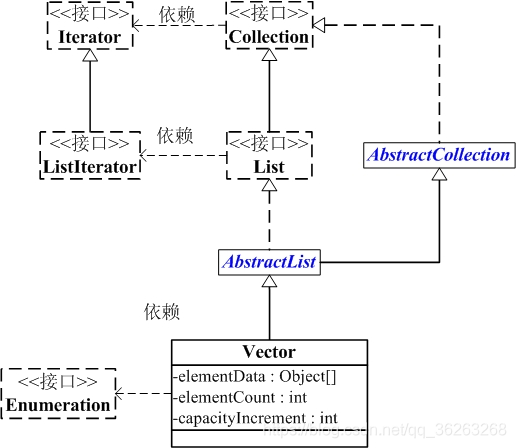Java集合源码分析(四)——Vector
简介
Vector 是矢量队列,它是JDK1.0版本添加的类。继承于AbstractList,实现了List, RandomAccess, Cloneable这些接口。
和ArrayList不同,Vector中的操作是线程安全的。

源码分析
public class Vector<E>
extends AbstractList<E>
implements List<E>, RandomAccess, Cloneable, java.io.Serializable{}
实现接口
- List
- RandomAccess
- Cloneable
- java.io.Serializabl
父类
- AbstractList
字段
- elementData :存放实际的元素值。
- elementCount :表示存放的元素数量。
- capacityIncrement :数组的增长系数。也就是每次扩容增加的大小,小于等于0,容量就会增长一倍。
- serialVersionUID:代码版本。
- MAX_ARRAY_SIZE :代表这个集合最多能装元素的数量。
protected Object[] elementData;
protected int elementCount;
protected int capacityIncrement;
private static final long serialVersionUID = -2767605614048989439L;
private static final int MAX_ARRAY_SIZE = Integer.MAX_VALUE - 8;
方法
1.构造函数
public Vector(int initialCapacity, int capacityIncrement) {
super();
if (initialCapacity < 0)
throw new IllegalArgumentException("Illegal Capacity: "+
initialCapacity);
this.elementData = new Object[initialCapacity];
this.capacityIncrement = capacityIncrement;
}
public Vector(int initialCapacity) {
this(initialCapacity, 0);
}
public Vector() {
this(10);
}
public Vector(Collection<? extends E> c) {
elementData = c.toArray();
elementCount = elementData.length;
// c.toArray might (incorrectly) not return Object[] (see 6260652)
if (elementData.getClass() != Object[].class)
elementData = Arrays.copyOf(elementData, elementCount, Object[].class);
}
2.扩容
// 给外部使用的扩容函数
public synchronized void ensureCapacity(int minCapacity) {
if (minCapacity > 0) {
modCount++;
ensureCapacityHelper(minCapacity);
}
}
// 内部需要扩容的时候调用的方法
private void ensureCapacityHelper(int minCapacity) {
// 判断是否需要扩容
if (minCapacity - elementData.length > 0)
grow(minCapacity);
}
private static final int MAX_ARRAY_SIZE = Integer.MAX_VALUE - 8;
// 真正执行扩容的代码
private void grow(int minCapacity) {
// overflow-conscious code
int oldCapacity = elementData.length;
// 计算需要扩多大,根据创建对象的时候的扩容系数来确定,如果扩容稀疏大于零,则每次扩容的增加数量就是扩容系数,如果小于等于零,容量就增加一倍。
int newCapacity = oldCapacity + ((capacityIncrement > 0) ?
capacityIncrement : oldCapacity);
// 如果重新计算出来的还比原来小,那么就以最小要求的大小为扩容标准
if (newCapacity - minCapacity < 0)
newCapacity = minCapacity;
// 判断边界
if (newCapacity - MAX_ARRAY_SIZE > 0)
newCapacity = hugeCapacity(minCapacity);
// 利用数组拷贝建立新的大小的数组
elementData = Arrays.copyOf(elementData, newCapacity);
}
private static int hugeCapacity(int minCapacity) {
if (minCapacity < 0) // overflow
throw new OutOfMemoryError();
return (minCapacity > MAX_ARRAY_SIZE) ?
Integer.MAX_VALUE :
MAX_ARRAY_SIZE;
}
3.元素查找
// 根据元素值查找元素位置,从index位置开始正向查找
public synchronized int indexOf(Object o, int index) {
if (o == null) {
for (int i = index ; i < elementCount ; i++)
if (elementData[i]==null)
return i;
} else {
for (int i = index ; i < elementCount ; i++)
if (o.equals(elementData[i]))
return i;
}
return -1;
}
4.获取元素
// 获取对应位置的元素
public synchronized E get(int index) {
if (index >= elementCount)
throw new ArrayIndexOutOfBoundsException(index);
return elementData(index);
}
// 获取对应位置的元素
public synchronized E elementAt(int index) {
// 判断边界
if (index >= elementCount) {
throw new ArrayIndexOutOfBoundsException(index + " >= " + elementCount);
}
return elementData(index);
}
// 返回类型转换之后的值
E elementData(int index) {
return (E) elementData[index];
}
5.设置元素值
// 将指定位置的元素值替换,返回旧值
public synchronized E set(int index, E element) {
if (index >= elementCount)
throw new ArrayIndexOutOfBoundsException(index);
E oldValue = elementData(index);
elementData[index] = element;
return oldValue;
}
// 将指定位置的元素值替换
public synchronized void setElementAt(E obj, int index) {
if (index >= elementCount) {
throw new ArrayIndexOutOfBoundsException(index + " >= " +
elementCount);
}
elementData[index] = obj;
}
6.删除元素
// 删除指定位置的元素值
public synchronized void removeElementAt(int index) {
modCount++;
// 边界判断
if (index >= elementCount) {
throw new ArrayIndexOutOfBoundsException(index + " >= " +
elementCount);
}
else if (index < 0) {
throw new ArrayIndexOutOfBoundsException(index);
}
// 计算需要向前移动的元素个数
int j = elementCount - index - 1;
if (j > 0) {
// 将被删位置的元素都向前移动一格,覆盖原有元素
System.arraycopy(elementData, index + 1, elementData, index, j);
}
// 更新容器元素数量
elementCount--;
// 将最后的元素值对象回收
elementData[elementCount] = null; /* to let gc do its work */
}
// 删除指定元素对象
public synchronized boolean removeElement(Object obj) {
modCount++;
// 获取该对象的索引
int i = indexOf(obj);
if (i >= 0) {
//
removeElementAt(i);
return true;
}
return false;
}
7.添加元素
// 在末尾添加元素
public synchronized void addElement(E obj) {
modCount++;
// 扩容判断
ensureCapacityHelper(elementCount + 1);
// 元素赋值到数组中
elementData[elementCount++] = obj;
}
public synchronized boolean add(E e) {
modCount++;
ensureCapacityHelper(elementCount + 1);
elementData[elementCount++] = e;
return true;
}
8.克隆
// 克隆方法
public synchronized Object clone() {
try {
@SuppressWarnings("unchecked")
// 调用父类的克隆接口函数获得一个父类再做类型转换
Vector<E> v = (Vector<E>) super.clone();
// 利用数组复制函数,将当前数组复制到新对象的数组中
v.elementData = Arrays.copyOf(elementData, elementCount);
v.modCount = 0;
return v;
} catch (CloneNotSupportedException e) {
// this shouldn't happen, since we are Cloneable
throw new InternalError(e);
}
}
9.转化为数组
// 无参数转换
public synchronized Object[] toArray() {
return Arrays.copyOf(elementData, elementCount);
}
// 利用模板数组转换
public synchronized <T> T[] toArray(T[] a) {
if (a.length < elementCount)
// 如果模板数组太小了,就新建一个数组作为返回
return (T[]) Arrays.copyOf(elementData, elementCount, a.getClass());
System.arraycopy(elementData, 0, a, 0, elementCount);
// 以null结尾,防止与原来的元素进行混淆
if (a.length > elementCount)
a[elementCount] = null;
return a;
}
总结
源码总结
- Vector和ArrayList一样是通过一个数组去保存数据的。当我们构造Vecotr时;若使用默认构造函数,则Vector的默认容量大小是10。
- 当Vector容量不足以容纳全部元素时,Vector的容量会增加。若容量增加系数 >0,则将容量的值增加“容量增加系数”;否则,将容量大小增加一倍。
- 和ArrayList不同的是,Vector对外部的操作都是加了synchronized 同步阻塞的,这样,当一个线程在操作Vector的时候,其他线程都只能等待。
- 其他操作和ArrayList都是差不多的。
问题总结
与ArrayList的异同:
- 因为内部都是用数组存储数,同样是使用随机访问是最快的,删除中间元素需要移动后面的元素。
- 因为Vector对外部的操作都加了synchronized,所以,开销比ArrayList会大,大在同步机制的额外操作上。


